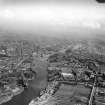Following the launch of trove.scot in February 2025 we are now planning the retiral of some of our webservices. Canmore will be switched off on 24th June 2025. Information about the closure can be found on the HES website: Retiral of HES web services | Historic Environment Scotland
Glasgow, Linthouseship Building And Engineering Works
Engineering Works (19th Century) - (20th Century), House (18th Century), Shipyard (19th Century) - (20th Century)
Site Name Glasgow, Linthouseship Building And Engineering Works
Classification Engineering Works (19th Century) - (20th Century), House (18th Century), Shipyard (19th Century) - (20th Century)
Alternative Name(s) Lint House
Canmore ID 167782
Site Number NS56NW 206
NGR NS 5399 6627
Datum OSGB36 - NGR
Permalink http://canmore.org.uk/site/167782
- Council Glasgow, City Of
- Parish Govan (City Of Glasgow)
- Former Region Strathclyde
- Former District City Of Glasgow
- Former County Lanarkshire
LINTHOUSE
The David Hamilton-style Mansion was built in 1791 on the 8-hectare (20-acre) Spreul estate of Linthouse. It became the residence of Michael Rowand, cashier of the Ship Bank. Alexander Stephen moved his shipyard across the river, then to Linthouse in 1869. The firm was actually founded at Burghead in 1750. The yard was later merged into Upper Clyde Shipbuilders (UCS), but closed in 1970 and the site is now occupied by an industrial estate. Stephen used the mansion for his offices until 1921, when the house was demolished and the porch re-erected in Elder Park. The estate was developed for housing after the shipyard was opened.
Taken from "Greater Glasgow: An Illustrated Architectural Guide", by Sam Small, 2008. Published by the Rutland Press http://www.rias.org.uk
NMRS REFERENCE:
Glasgow, Linthouse.
Demolished
Porch re-erected in Elder Park.
Desk Based Assessment (6 June 2016)
Nothing is visible of this industrial site in an area of the S bank of the River Clyde now occupied by a factory, its car park and an area of ground to the east that is presently waste ground. In the 1860s the land was occupied by a large private house (Linthouse, NS56NW 206) and its policies, the extent of which are depicted on the 1st edition of the OS 6-inch map (Lanarkshire 1858, Sheet V). By the 1890s, however, it was occupied by the Linthouse Ship Building and Engineering Works, details of which are shown on the 2nd edition of the map (Lanarkshire 1898, Sheets V.NE and SE). The roughly rectangular-shaped yard, which measured about 14.7ha in area, contained numerous buildings, including three very large sheds, and although there was no slipway or quay, a long boat-shaped inlet had been dug into the length of the river bank. There was also a landing stage.
Information from HES Survey and Recording (JRS) 6 June 2016.





















